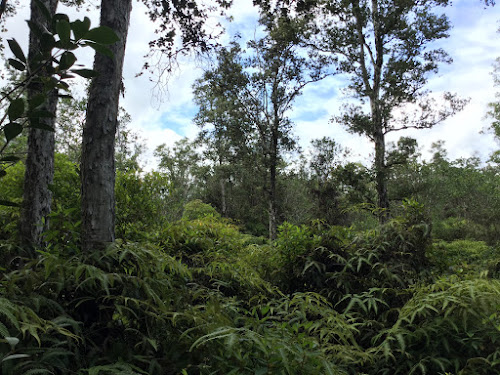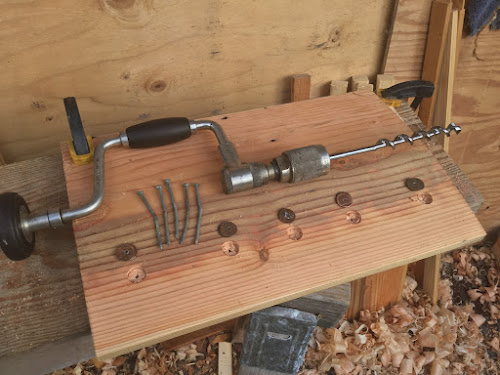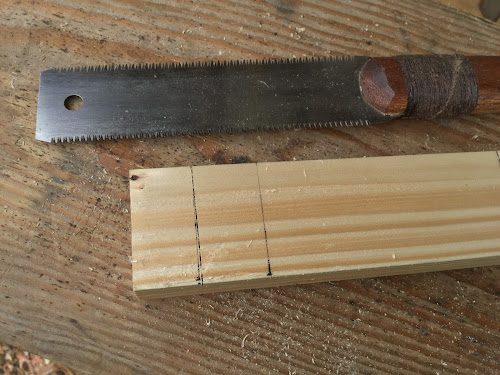In December of 2014, Eliana, Renee and I moved from the cold, windy and wet Oregon coast, to the Big Island of Hawaii (the Hilo side) for Renee to take a postdoctoral position with the University of Hawaii Hilo. Although Renee had been to Hawaii in the past, this side of the island was new to her. This is my first exposure as well.
Hilo has the reputation as being a VERY wet place, actually one of the top-whatever cities worldwide in terms of annual precipitation. The numbers don't lie, this place gets phenomenal amounts of rain, the more so the further up you go in elevation. Our houshold landed outside the small town of Mountain View, about 12 miles to the south/southwest of Hilo, and at an elevation of about 1,400', the rainfall maps suggest that this place gets a deluge of somewhere around 258" of rain annually. That's about 20 FEET of rain,hahahahahaha ***insert maniacal laughter***! At least it is warm here.
In the 8 months time that we have been here, we've all learned a lot about some lesser known aspects of living a rather unconventional lifestyle. While much of this knowledge is particular to this area (like living 24/7 outside, but with no real fear of freezing), some other aspects will have broader application that might be interesting and fun, particularly to those of you out there who aspire towards a less energy intensive life.
A long time ago, I lived for two years time completely off-grid, though then it was in the wilds of northwestern Montana state, as well as being in the dark ages of the communication and alternative energy scene. This was back in 1990 about, and the internet thing was just beginning to ramp up. Online shopping was still viewed with extreme suspicion, and the only real companies out there were the already established brick and mortar guys, so prices were the same as what you'd find in a catalog. Solar was the "grail", but was still REALLY expensive, and there just weren't any cheap Chinese alternatives. I was so poor, the point was moot, but I was always dreaming.
I lived way out in the sticks on 20 acres of trees, between the small town of Thompson Falls and the even tinier town of Trout Creek, out on Blue Slide Road with the other white trash. Though I didn't have running water or electricity, while I was there a new phone company opened up and offered to run line in for free, so for part of that time I was in the ironic situation of being able to chat online with people on the other side of the world in new Zealand, yet I didn't have a flush toilet. What little power I did have came from 4 ,6-volt batteries that I charged using an ever rotating series of continually breaking generators.
Years after that adventure, I became enraptured with the idea of sailing around the world, living on a sailboat and just doing whatever it is that I normally do, which is work on stuff. They say that sail cruising is the adventure of constantly working on boats in exotic locations, and in my experience that saying holds true. The perfect life for someone like me! Sailboats are like small, self-sufficient nations, with limited contact with the greater world. ALL people living on cruising sailboats are living an alternative energy lifestyle, and boats run the range from having no power at all, to some boats having all the comforts of home.
All of this blather is to say......I've been there, done that. I'm not totally new to this stuff, I have a clue. I am a MacGuyver, and I can fix most anything. I'm not saying that I'm some alternative living "rockstar" actually, because it has been my far too many mistakes that have taught me so much. I wish that I had been smart enough to write stuff down, so that I didn't need to make the same mistakes over again.
Maybe THAT is why our move to Hawaii, how we've been living for the last 8 months, has been so especially odd. I've done so much the "wrong" way, put my family through such ridiculous levels of deprivation, it defies description. That they still talk to me is a small miracle, and testament to how amazingly wonderful Renee and Ellie are. You both are truly beyond compare, and I can't express how fortunate I feel to be with you both.
Renee is so wonderful in fact, that she is giving me a second chance. An opportunity to do this the "right" way, to design a simple, economical, and beautiful life.
We bought a place. 3 acres on a dead end road,lots of trees. Cash, no loans, ours for the family in perpetuity. Our fingers are still crossed, as we just heard that there might be some difficulty with the title, but hopefully things will work out.
Here it is.
This two-track is Napua street.
Ellie is standing at pole 7.
One of the amazing things about living on the wild side of Hawaii (as opposed to the other, poopy side, with the sun and too many people) is that you can tell people that your address is "the first driveway on the left, after pole #7", and that's OK. Ellie says, to tell you that there is a wood-spirit hiding somewhere in this picture, if you look closely.
Lots of green stuff.
Thankfully there is one area right by the road, that should be fairly easy to clear. Perfect for a parking area, maybe a little workshop.
That might be wishful thinking, as it seems like the only reason that there wouldn't be any trees right here would be because underneath all of that lovely Uluhe fern (Scientific Name: Dicranopteris linearis)......that's probably solid lava there.
It's funny, looking for property in these undeveloped areas. The photos of the places are often just walls of greenery. There's just not a good way to photograph this stuff, and because the area closest to the road gets such good sunlight, the growth is typically extra dense.
Once you bust through the green wall, the land has a little more room to breathe.
Walking in this is still VERY challenging, as the guava trees can easily form impenetrable thickets. This day, Ellie and I grabbed the tablet with built-in GPS and tried to map out the property boundaries. Not the best, but better than nothing.
Much to Ellie delight, there is a significant population of wild pigs that live in the area. They have a bad rep, for digging up yards looking for anything edible. Here is what is referred to as, "pig damaged forest".
The pigs (wild pheasants,too) are one of the principal culprits in the spread of the Guava trees, eating the fallen fruit then planting the seeds, pre-fertilized. If you have pigs in the area, you've got guava too.
So much of life is about how you deal with your perception of "undesirable aspects. People hate the pigs because they dig up their gardens, foul their lawns, wreck our carefully planned landscaping. It will be one of our challenges, to find ways to plant that will guide the pigs around and elsewhere.
Ellie is happy that there are pigs, because it is one of her greatest wishes to hunt wild pigs.....dreams of killing the largest boar, using only a spear. WTF? We aren't hunters, don't have guns or walls covered with animal heads, but as soon as Ellie learned that there was just the slightest possibility of us moving to Hawaii, she began researching hunting upportunities. Strange creature that she is, she has been a hunter since she hit the ground. Go figure.
It's not all Guava trees. There are many of the large and extremely slow growing native 'Ohi'a Lehua (Scientific Name: Metrosideros polymorphism).
Back in here, I see a lovely big tree, but I've no idea what it is.
Very interesting and distinctive bark, but I haven't found a match yet. 30' main stem, then lateral branching. At a guess, 60-70' tall, and the overstory is too thick for me to see which leaves belong to which plant.
Doesn't really matter, because the GPS says it's probably on the neighbors property anyways. I was having a REALLY hard time staying on track. The jungle is seriously thick.
There are a number of areas where the lava is fissures, creating wonderful places for trolls to hide.
Hapu'u fern (Scientific Name: Cibotium spp.)
This tree fern is well over 12' tall, but the base is obscured by the Uluhe.
By now I've been in here for over an hour. The property dimensions are very long and skinny, a so-called "spaghetti lot", 125'x 1045'. Of the 1045' depth, I've MAYBE seen 300' of it, and I doubt that anyone else has either. These trees are upwards of 400 years old, some of them, and this area has never been logged/farmed/developed in any way. The current owner has never even seen the place.
It's going to take a machete at the least, before I can see more, as I've gotten as far in as I can. Stopped dead by the thickness of the ferns, and the Uluhe are growing taller than I can see over, at least 6' tall.
I hold the camera over my head, point it in the likely direction, and take a few photos.
Now you know as much as I do about the property. Seriously, these pictures are all we have, haha. What's back there? There's still about 800' we haven't seen.
On my way back to the car.....it's a good thing I've got the GPS, as I was getting completely disoriented, absolutely turned around.
I find a couple of small pools of standing water.
Now we know why there are so many mosquitos here, haha. Ellie's psyched, hoping for bullfrogs, researching aquaculture.....she's now planning on raising Tilapia fish.
So many fun things to do!
So.....
I screwed up the first time, planned for the right things, just not at the right times. I can do better. This time....we hit the ground running.



















































































